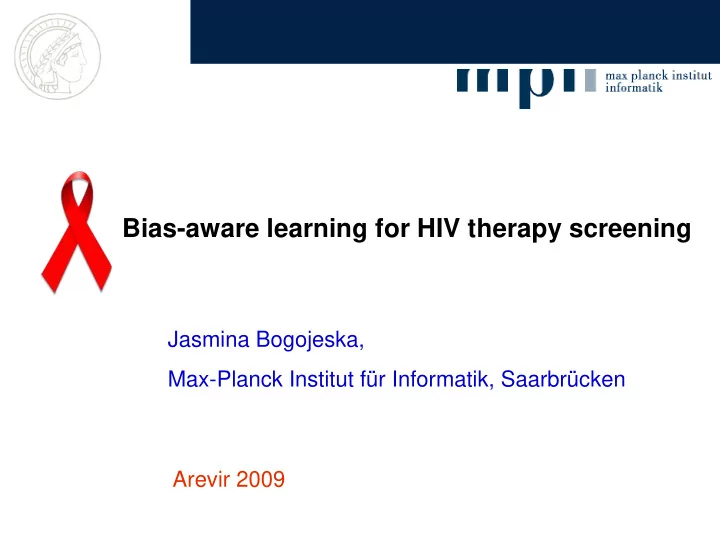

Bias-aware learning for HIV therapy screening Jasmina Bogojeska, Max-Planck Institut für Informatik, Saarbrücken Arevir 2009
Overview Problem setting Transfer learning with distribution matching Conclusions
Problem setting Bias-aware prediction of the outcome of combination therapies given to AIDS patients older recent Develop methods that can deal with: Different trends in treating patients Evolution of the viral sequence under drug pressure over time Uneven therapy representation
Multi-Task Learning Multi-task learning several related tasks learn a model for each task from all available data by utilizing their similarity Our approach in the HIV setting very scarce training data drug combinations (tasks) have similar but not identical effect on the virus each combination therapy is a separate task learn a model for each therapy by using all available data with proper weights
Multi-Task Learning Goal: Fit the best model for a specific target therapy t ( , | ) p y t x = Model ( , ) Model [ ( , )] w y y x x ∑ target ~Target ~Training x x ( ) ( , | ) p z p y z x z x Target distribution Training distribution
Multi-Task learning with distribution matching How to estimate the resampling (similarity) weights? ⎡ ⎤ target distr. [ ] = Model ( , ) Model ( , ) ⎢ ⎥ y y x x ~Target ~Training x x ⎣ ⎦ training distr. Simple logistic regression model – data points closer to the decision boundary will get higher weights rest target LOGREG
Therapy similarity kernels Prior information on therapy similarity defined with a similarity kernel Drug feature kernel: based on the drugs used in the therapy Mutation table kernel: based on similarity of resistance-relevant mutations importance 0.8 0 0.4 0.6 0 muts(th1) 1 0 1 1 0 sim(th1, th2) sim(gr1) avg(sim(gr1),sim(gr2),sim(gr3)) muts(th2) 1 0 1 0 1 importance 0.6 0 0.5 0 0.7 drug group 1
Algorithm Step 1 Learn the importance weights – logistic regression model that separates the target therapy data from the rest of the data in the training set Step 2 Train a target model – logistic regression model fitted on the training data weighted with the similarity weights obtained in step 1
Results Special evaluation setup to address evolving trends in treatments over time 80% training 20% test Distribution matching performs best initial response sustained response separate one-size- hier. Bayes hier. Bayes distribution fits-all kernel Gauss. Proc. matching Bickel, S. et al., 2008. in Proceedings of ICML .
Conclusions Using the transfer learning paradigm for predicting outcomes of HIV therapies Learning separate models for each therapy by using all available data with proper weights Time-aware evaluation setup to encounter changing trends in HIV treatment and virus evolution over time
Acknowledgements Thomas Lengauer Steffen Bickel, Tobias Scheffer HIV group @ MPII Saarbrucken Andre Altmann Alexander Thielen Kasia Bozek Joachim Büch EuResist
Thank You!
Data Data representation occurrence of Viral genotype 0 1 0 0 1 … resistance mutations drugs used in Current treatment 1 0 0 1 0 … current treatment drugs used in all Treatment history 1 1 0 0 1 … previous treatments Label (success or failure) Sustained response (2252 samples) Initial response (3385 samples)
Labeling Sustained response labeling (2252 labeled samples, 454 different therapies) success Initial response labeling (3385 labeled samples, 538 different therapies) success
Recommend
More recommend